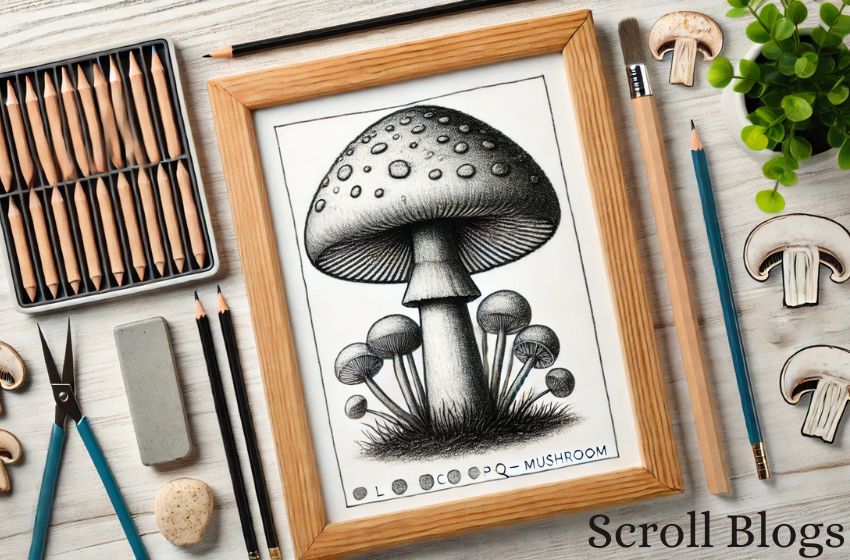Creating a masterpiece often starts with mastering the basics, and “drawing:plcxcsjeqpq= mushroom” has become a trending topic among art enthusiasts. This unique term hints at a fascinating approach to drawing mushrooms, a subject beloved for its natural charm and intricate details. In this comprehensive guide, Scroll Blogs explores the skills, techniques, and tips you need to enhance your understanding of “drawing:plcxcsjeqpq= mushroom.” Whether you’re a budding artist or an experienced illustrator, you’ll find valuable insights to elevate your mushroom-drawing skills.
Understanding Drawing:plcxcsjeqpq= Mushroom and Its Significance
The phrase “drawing:plcxcsjeqpq= mushroom” may sound peculiar, but it encompasses a unique approach to drawing mushrooms. Artists often choose mushrooms for their varied shapes, textures, and organic beauty. The process of drawing mushrooms can sharpen your skills in observation, shading, and texture detailing, making it a versatile subject in art. For many, the practice of “drawing:plcxcsjeqpq= mushroom” is about capturing the essence of nature in a simple yet elegant way, allowing creativity to bloom with each stroke.
Essential Tools for Drawing:plcxcsjeqpq= Mushroom
To begin with “drawing:plcxcsjeqpq= mushroom,” it’s essential to gather the right materials. Basic supplies include pencils, erasers, fine-line pens, and a good-quality sketchbook. Scroll Blogs recommends experimenting with different pencil grades to achieve various shading effects. Additionally, having reference images or observing real mushrooms can provide inspiration and guidance. Tools like blending stumps or cotton swabs are also useful for achieving soft shadows and textures, crucial in making your mushroom drawings come to life.
Step-by-Step Process for Drawing:plcxcsjeqpq= Mushroom
Step 1: Start with Basic Shapes
Begin by sketching the basic shapes that define the mushroom structure—typically, a circular cap atop a cylindrical stem. “Drawing:plcxcsjeqpq= mushroom” focuses on starting with a light hand, allowing you to adjust proportions as needed.
Step 2: Add Details to the Cap and Stem
Once you have the basic outline, add details to the cap, like ridges, spots, or scales. This step requires careful observation, as each mushroom species has unique textures. For the stem, use vertical lines to create a realistic bark-like effect, enhancing the authenticity of your drawing.
Step 3: Develop the Texture and Depth
Shading is crucial for “drawing:plcxcsjeqpq= mushroom.” Begin shading the underside of the cap, adding shadows to suggest depth. Use different pencil grades to vary the intensity of the shading. Scroll Blogs emphasizes the importance of soft strokes and layering, as these techniques bring out the natural textures in mushrooms.
Step 4: Refine and Finalize Your Drawing
The final step is adding the finishing touches, which may involve erasing unnecessary lines, enhancing shadows, or detailing specific parts of the mushroom. This phase solidifies the realistic look, making “drawing:plcxcsjeqpq= mushroom” a satisfying and rewarding experience.
Common Mistakes to Avoid in Drawing:plcxcsjeqpq= Mushroom
Like any art form, “drawing:plcxcsjeqpq= mushroom” comes with its challenges. Here are some mistakes to watch out for:
- Overdoing Details Too Early: It’s easy to get carried away with intricate details, but this can complicate the drawing process. Start simple, then build up the details gradually.
- Neglecting Reference Images: For realistic results, always refer to photos or real mushrooms to understand their natural forms.
- Heavy Hand with Shading: Mushrooms have delicate textures, so a soft hand with shading is essential to maintain a lifelike appearance.
Benefits of Practicing Drawing:plcxcsjeqpq= Mushroom
Practicing “drawing:plcxcsjeqpq= mushroom” offers numerous benefits for artists of all skill levels. It can improve hand-eye coordination, enhance observation skills, and provide a peaceful, meditative experience. Scroll Blogs suggests that regular practice of mushroom drawing can also prepare artists to tackle more complex subjects, as it teaches patience and precision.
Tips to Master Drawing:plcxcsjeqpq= Mushroom
- Experiment with Mediums: Try ink, charcoal, or even watercolor to explore different effects. Each medium brings a new dimension to “drawing
= mushroom.”
- Observe Real Mushrooms: Studying real mushrooms helps in understanding their shape, texture, and color, which can make your drawings more accurate and detailed.
- Practice Consistently: Like any art form, consistency is key. Dedicate time each week to work on “drawing
= mushroom” and gradually improve your technique.
Advanced Techniques for Drawing:plcxcsjeqpq= Mushroom
For those who have mastered the basics, here are some advanced techniques to explore:
- Texturing with Stippling and Cross-Hatching: These techniques create intricate textures on the mushroom’s cap and stem, adding depth and realism to your work.
- Adding Surrounding Elements: Enhance your mushroom drawing by including surrounding elements like leaves, grass, or other forest elements. This brings context to the drawing and makes it more visually appealing.
- Using Light and Shadow: Learning to play with light and shadow can add drama and dimension to your drawing. Experiment with different light sources to see how shadows fall across the mushroom’s surface.
Final Thoughts on Drawing:plcxcsjeqpq= Mushroom
“Drawing:plcxcsjeqpq= mushroom” is more than a simple drawing exercise—it’s a journey into the beauty of nature and a chance to refine your artistic skills. As Scroll Blogs highlights, this creative pursuit brings a sense of tranquility and allows artists to hone techniques that are useful across various art styles. Whether you’re drawing for relaxation or to build your portfolio, focusing on mushroom illustrations can be a fulfilling artistic endeavor.

